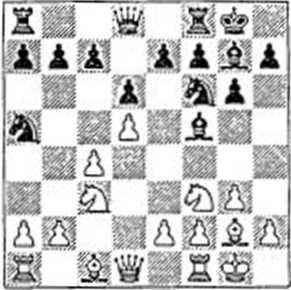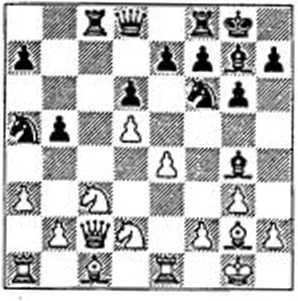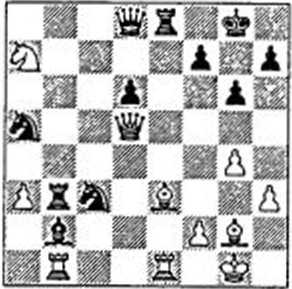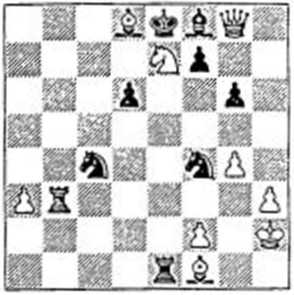1 General Principles of Opening Play
Artur Yusupov
Let us ask what constitutes the strategy of the opening struggle in chess. If you examine the games of strong masters, you will see that both sides aim above all to mobilise their forces with the greatest speed. This is easily explained; the more pieces in play, the more attacking possibilities you have. Fast development is the basis of opening play.
Here is a second important factor: from the very first moves, a battle for the centre is fought. The centre may be called the commanding summit of chess strategy; whoever gains control of it will afterwards have the better prospects. It is natural for the central squares c4. e5, d4 and d5 to be the object of constant attention by both sides from the very outset. As a rule, chessplayers endeavour either to seize the centre with pawns or to exert pressure on it with pieces.
At the same time, both opponents are trying to frustrate each other's plans. It makes sense to play a move which hampers the opponent’s development; if this 'loses a tempo', it is likely to be justified later. It is well worth spending a tempo to prevent the opponent (say) from castling - in this way you will increase your own lead in development Thus, the third principle of opening play is to counteract the opponent's intentions with a view to holding up his development and stopping him from gaining control of the centre.
You will ask which is more important: pursuing one’s own development or hindering that of the opponent. Of course it is ideal if both can be combined. If the choice must be made, it will depend on the particular circumstances of each single case; there is no universal precept. That said, it is better not to forget about developing your own position.
What else matters to a chessplayer in the opening? Of course, he gives attention to his pawn structure. It may already be possible at an early stage to provoke a weakening of your opponent’s pawn position - to wreck his pawns, as they say. Remember that a great deal may depend on whether you obtain a good pawn structure or a bad one.
And, finally: from the very first moves, a struggle for the initiative is under way, and this perhaps is the very essence of opening play. In our day, can we imagine a game in which the players spend some time simply bringing out their pieces and then look round to sec where they stand and what they should he doing next? Of course not It is natural that White, as the ‘first player’, should generally try to keep ahead of his opponent in development, to seize the centre and to create the First threats.
Before passing to specific examples, I would draw your attention to one more important point: Modern opening structures are firmly linked to a middlegame plan of action (and sometimes you even have to take the eventual endgame structure into account'). These days it is hard to draw a clear line between the opening and the middlegame, especially since all the principles of opening strategy that I have mentioned can be applied to the middlegame too, though in rather different ways.
Let us now look a little more closely at the first of the opening maxims (fast mobilisation of the forces). Some simple rules may be called to mind:
-
1) Don’t move the same piece twice (without serious justification).
-
2) Don’t waste time on prophylactic moves with the rook’s pawns; developing the pieces faster is more important
-
3) Don’t bring the queen out loo early, choosing the right place for it is a crucial task, since the nature of the subsequent struggle is in many ways dependent on where the queen is placed.
-
4) Don’t be rushed into a premature, unprepared attack.
-
5) Don't go in for pawn-hunting, especially in open positions where a lead in development makes an immense difference. Remember that a tempo in the opening is sometimes more important than a pawn.
We will now examine a game of mine against Grandmaster Gulko. I think that the principles of mobilization and general opening play will be clarified by this example.
Yusupov-Gulko Reykjavik 1990 King’s Indian
Wc see how new forces arc entering the game with each move. White seizes the centre with his pawns; Black prepares to exert pressure on it with his pieces.
-
7 &3 ДГ5
A move that is rarely seen but perfectly playable. Black develops his bishop and establishes control over the central square e4, preparing to play 8...£c4.
-
8 d5
There are other continuations here, for example 8 2c 1, 8 b3 or 8 £cl. The move played is also logical enough: with gain of tempo, White makes good his conquest of space in the centre.
8 -. £>a5 (1)
Black moves the same piece twice in the opening, but here he is justified in doing so. For one thing a' knight move is actually forced, but secondly the move 8...£}a5 creates a counter-threat against the pawn on c4.

What should White play here? In the game, I continued...
-
9 €jd2?J
But this move has definite snags. The knight on d2 blocks the bishop on cl. I was hoping that the threat of 10 b4 would force my opponent to close the queensidc with ...c7-c5. White would then gain a tempo by pushing his pawn to c4 and afterwards complete his development with Wc2, Ь2-Ь3, ДЬ2 etc. Unfortunately, events look a very different turn.
A more natural and logical move seems to be 9 £d4! The bishop on f5 is attacked, and the c-pawn is defended indirectly: 9...5ixc4? would be met by 10 4?>xf5 gf 11 tfd3, whereupon White recovers his pawn while obtaining the better pawn structure. After 9...&d7 10 й^З, his position is highly promising.
-
9 ... c6!
Having gained a certain lead in development, my opponent resolutely opens the position up. I am now faced with a new problem - that of damping down Black’s incipient initiative. I failed to solve this problem and landed in trouble.
The logical sequel to 9 £d2 would be the energetic 10 b-4!?. The basic idea, which I overlooked during the game, is that after 10...Qxd5 11 cd ДхсЗ White has 12 c4! (I only considered 12 ДаЗ? Axd2). White will probably manage to acquire two pieces for a rook, but Black will have some pawns as compensation. Assessing such a position is very difficult; quite possibly it is a case of dynamic equilibrium.
In the game, White played the stereotyped...
-
10 c4?!
To which the answer was:
-
10 ... Ag4!
With this cunning move, a new weakness is provoked: cither f2-f3, giving Black tactical possibilities based on ...Wb6+; or else Wc2, when after the opening of the c-filc the queen will be exposed to awkward pressure from a rook on c8.
-
11 Wc2 cd
-
12 cd
Taking with the c-pawn would be even worse - Black's bishop would obtain the excellent square f5.
-
12 ... mc8
Observe the logic with which Gulko brings fresh forces into the game while gradually increasing the pressure. Taking advantage of White’s conventional play and consequent backward development. Black has already seized the initiative. He now has to follow a very important rule formulated long ago by Steinitz: when you have the advantage, you must attack, or risk losing it!
-
13 Eel
White endeavours to co-ordinate his pieces somehow or other. He prepares to continue developing with 14 £>f 1, and at the same time prevents the black bishop from transferring itself via e2 to a6, from where it would exert dangerous pressure.
-
13 ... b5
There were other possibilities here too, for example 13...'ВЪ6. It was also worth considering 13..JLd7, freeing the g4 square for the knight on its way to e5, while planning to meet 14 Qfl with 14...Фс4.
-
14 a3 (2)
2 в

Again Black could continue 14...Ad71? 15 Qfl <£c4 16 Qe3 £)g4. But Gulko has found a much more interesting line based on the same overall assessment of the position as before: Black is ahead in development, so opening up the game will benefit him.
-
14 ... c61?
After a pawn exchange on d5, the bishop obtains the f5 square, which is extremely unpleasant for White. If instead 15 h3?l, there follows 15...ed 16 hg d4, and my pawn position will be hopelessly spoilt. In other words. Black will convert one type of advantage - his lead in development -into another the better pawn structure.
White has to adopt a defensive approach which could be stated more or less like this: ‘When everything is going badly, it’s too late to be afraid’’
IS w
Well, what is White to do? Already I realize that completing my development is impossible by normal means, and so I am trying anything to complicate the struggle. Such tactics can sometimes give quite good practical results, though with correct play from the opponent they are likely to be punished. At any rate, the quiet 15 Qf 1 (15...cd 16 ed) was objectively the lesser evil.
-
15 ... cd
-
16 Qxb5
Whereas for White the opening is not yet over, Black of course is well into the middlegame. At this point he could have played 16...',&Ъ6!?, enabling his bishop to retreat to d7. The exposed bishop on g4 is perhaps the only defect in Black’s position - in some lines it can be cut off from the rest of his forces.
However, from the point of view of fighting for the initiative, Gulko played what is probably the most effective move:
-
16 ... Se81?
One more black piece enters the game...
From this point onwards, balancing on the edge of a precipice, I managed time and again to unearth resources for prolonging the fight. Fortunately for me. the position proved sufficiently complex, so that at this stage it was too early to say how it would all end.
-
17 h3 AfS!
A tempting move. An alternative was 17...Дсб, when there would follow: 18 ed ДГ5 19 Sxe8+ <xe8 20 Ш1. White has an extra pawn, though of course Black has powerful counterplay.
-
18 g4
The only move. Albeit at the cost of a pawn. White succeeds in finishing his development.
-
18 ... Дхе4
-
19 €ixe4
At last this knight has left d2!
-
19 ... £xe4
With White’s development still backward, winning the pawn back with 20 Дхе4?! would be tantamount to surrender: 20...de 21 'S’xdG
Also 20 #xd5? would be bad in view of the very strong reply 2O...Ze5!.
20 Qxa7!?
In this game White breaks all the rules, and should have been punished by accurate play from his opponent. But I had come to the conclusion that the ‘normal’ course ofcvents was a hopeless prospect.
-
20 ... Sb8
If 21 'e’xdS?!, the tactical stroke 21...€1x121? looks tempting, for instance: 22 Sxe8+ ^xc8 23 ФхГ2 €ib3 24 Феб with unclear play. But the interposition of 21...Se5! would set White problems that appear insuperable; his pieces arc disunited, and the same fearsome blow against f2 is still threatened (22 #d3 Qxf2 23 ФхГ2 Wh4+1).
Naturally White must take the opportunity to mobilise his bishop which has remained idle so far:
-
21 ДеЗ
There now followed:
-
21 ... ДхЬ2
-
22 Sabi
On 22 Sadi, the reply 22...Qc3 is unpleasant, for example: 23 2d2 d4 24 3xb2 Sxb2 25 ^xd4 Qe2+ 26 5xe2 Sxe2, and if 27 ДЬб then simply 27...S8e5, blocking the dangerous diagonal and emerging with a big material plus.
-
22 ... Sb3
Gulko continues purposefully and finds a concrete method of increasing his advantage.
23 Wxd5
White would lose quickly with 23 »c2 Wb8 24 4кб £xc6 25 Wxc6 Ec8.
-
23 .... £c3 (3)
3 w

We have here an interesting problem of calculation. Which continuation promises White the best practical chances? Basically there are three possibilities:
-
(a) 24 >xb3 £xb3 25 Exb2 £c5. I think Black has the advantage here (though surrendering material like this docs sometimes help to repair the situation).
-
(b) 24 4k6 - objectively, this counter-stroke may be strongest. Yet after 24...4)xd5 25 £xd8 £xc3 Black of course has a clear plus (for example 26 ЕхеЗ ЕЬхеЗ 27 fe ДхаЗ).
-
(c) The move actually played, on which my hopes rested, was:
24 £gS
Black now has to solve one more complicated problem, after which he should score his deserved point.
The correct reponse is 24...Wd7!. But Gulko didn’t notice that after 25 i#'xa5 43xbl 26 Exbl Black has the deadly 26...Дс31. White would have to carry on confusing the issue with 26 Дсб (26 Exe8+ WxcS 27 Дсб ’йЪ8 is no better), but this would not last long: 26...Exel+ 27 Wxel Wxa7 28 We8+ £g7 29 ±c7 Eb8, and Black wins.
Fortunately for me, Gulko was tempted by a queen sacrifice:
24 ... 43xbl?
25 £xd8 Exel+
26 ДП
...which results in a wholly unclear position where the mutual threats appear balanced.
26 ... 4k3
27 «<12!
It is important to take control of f4. Bad alternatives arc 27 t»'a8? £e2+ 28 $g2 4M4+ and 27 Wxa5? £e2+ 28 *g2 43f4+ 29 *£g 1 £xh3+ 30<£g2 4M4+ 31 $gl ДсЗ.
28 Ф82
Black could have drawn with 29...£g7 30 Wd2 ДсЗ.
31 £c7+ ФГ8?
A mistake. The correct line was 31...*h8! 32 43xg6+! fg 33 ДГ6! Eb7 34 Дхе2 Exe2 35 £xg7+ Exg7 36 i»f4! with equal chances.
32 «xh7 £14+
33 ФЬ2 Фе8
34 Wg8+!
Not 34 Wxg7? Exfl followed by ...Exh3 mate.
34 ... дга (4)
Nor can he save himself with 34...*d7 35 tfxf7 2xfl 36 £c6+! Фхсб 37 Wxc4+ *d7 38 Wxb3.
4
IV

35 £ixg6’.
The way from victory to defeat has proved very short. After this stroke. Black's position is already indefensible (35...€lxg6 is met by the simple 36 Axc4).
35 ... fg
36 Wxc4 2xfl
37 tirxf4’.?
37 ’Й'хЬЗ $xd8 38 Wc4 3xf2+ 39 Ф§3 £ixh3! is also in While’s favour.
37 ... Sxa3
38 Ah4?
38 Af6!,controlling al, was more precise.
38 ... 3aal
39 #e4+
The consequences of 39 Wf6 arc unclear: 39...Shl+ 40 Sagl+ (or 4O...3hgl+!7) 41 ФО 2xh3+ 42 Фс2 (42 Ag37? 3hxg3+) 42...*d7.
39 ФГ7
40 Wf3+ *g8
41 Wd5+ *g7
|
42 |
Wb7+ |
Фg8 |
|
43 Ag3 Intending h3-h4. 43 ... |
3hl+ | |
|
44 |
Wxhl |
Sxhl+ |
|
45 |
ФхЫ |
фр? |
|
46 |
&g2 |
ФГ6 |
Better is 46...Феб.
|
47 |
f4 |
d5 |
|
48 |
Af2 |
Ad6 |
|
49 |
ФГЗ |
Феб |
|
50 |
Ad4 |
Ac7! |
|
51 |
d?g3 |
Ab4! |
|
52 |
h4 |
Acl+ |
|
53 |
Ф113 |
Ad2 |
|
54 |
ФgЗ |
Acl+ |
|
55 |
ДГ2 |
Ac3 |
|
56 |
ФГЗ |
Ag7 |
A more stubborn defence was 56...Af61? 57 h5 gh 58 f5+ ФП 59 gh, but even then the Black position could definitely not have been held. White would play Ae3, *3?g4, jLg5, and then Sa‘f3-c2-d3-c2-b3-a4, when the black pawn falls.
57 Aell?
57 Ab6!?, preparing ФеЗ and
|
Ad4, was also good. | ||
|
57 |
Af8?! | |
|
58 |
Ac3 |
Ah6?l |
|
59 |
f5+! |
gf |
|
60 |
g5 |
1-0 |
|
Black |
resigned |
in view of |
60...Д18 61 h5 Ф17 62ФГ4.
I would like to draw your attention once again to Gulko’s highly consistent play in this game, right up to his fateful error on move 24. He began fighting for the initiative right from the opening, and after gaining a lead in development he concentrated on increasing it, bringing more and more pieces into the fray and not shrinking from temporary sacrifices. The moves 14...c6! and I6...Sc8! may be singled out in this connection.
As regards White’s play, after offending against one of the cardinal opening principles (mobilisation at maximum speed) and conceding the initiative, he ought to have lost. However, what makes this game notable is that it shows the importance of carrying on the fight whatever the circumstances. True, White had the worse position. Yet he never lost heart, he strove to work up counter-play and regain the initiative. Eventually he managed to set his opponent some quite difficult practical problems, and the latter lost his way.
The next example is perhaps simpler. In contrast to the game with Gulko, I had properly prepared myself to meet Spassky.
Spassky-Yusupov
Linares 1990 Ruy Lopez